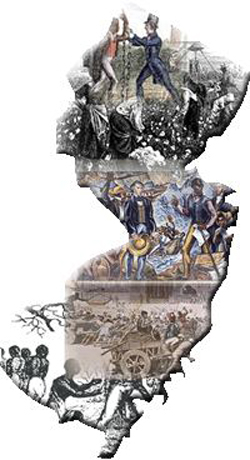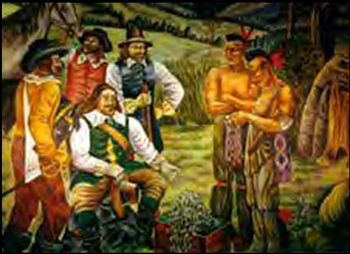Oakland History Reconsidered
Recap of Oakland History Presentation
Installment #2
By Kevin Heffernan
Land Patents and Slavery in Oakland!
The commonly accepted history of Oakland notes that this valley was prepared for settlement via the Schuyler Land Patent of 1694 and then the subsequent arrival of 10 founding families in 1695. This installment will explore the development and use of land patents as a tool for settlement and the role that they played in the specific settlement of this valley.
As an overview, the new world, America, was discovered as a result of state sponsored exploration in pursuit of a water route to India. While the European governments didn’t find that route, they did discover both North and South America and simply believed that they owned this continent with all of its natural resources. While the Dutch were the first to colonize this area, their vision was limited to the development of many small trading posts to exploit the beaver pelt trade. And they imported people and granted approvals within that approach. Their system of assigning territorial rights was very inefficient and made worse by very poor administration by the Dutch West India Company.
 Images of great amounts of guilders danced in the heads of the Dutch royalty. The only missing element was people to exploit the land and bring wealth from the Americas to the royal European purses. In order to cure the people problem, the Dutch basically bribed Europeans to settle here, used the concept of indentured servants and introduced slavery to America generally and New Jersey specifically.
Images of great amounts of guilders danced in the heads of the Dutch royalty. The only missing element was people to exploit the land and bring wealth from the Americas to the royal European purses. In order to cure the people problem, the Dutch basically bribed Europeans to settle here, used the concept of indentured servants and introduced slavery to America generally and New Jersey specifically.
In 1664 when the British arrived to remove the Dutch trespassers from their North American continental claims, their conquest was over a colony in existence for 40+ years and which had existing laws and customs. Among the many things that they found were two items that would have very significant impact upon Oakland in the future. First, they found slaves and a very interesting use of slavery to advance their objectives. The second thing that they found was the terrible method of land administration by the Dutch West India Company. By enhancing and using the former and fixing the latter, England positioned itself to benefit mightily from its investment America.
Initially, two things were required; Clearly defined geographic areas of economic opportunity and settlements with people to achieve the opportunity. To the former, the British developed the land patent system wherein the Crown through the local governor would make an exclusive grant of specific land to an individual for the purposes of development in the wilderness. But there were strings attached. One of them was that they had to populate the land patent within 6 years and failure to do so would cause the patent to return to the royal inventory.
 Most Oaklanders are aware of the mural in the old Ponds Memorial Building depicting a few European looking men having friendly negotiations with local Indians with a small trunk of beads. The background is illustrated with cleared land just perfect for farming. Ostensibly, the main European character depicted in the mural is Arent Schuyler, the date is 1694 and he supposedly is negotiating with the Indians for his land patent encompassing much of this valley. And the thought extends to the notion that his land patent was for the preparation of Oakland’s first settlers in the following year, 1695. Not so.
Most Oaklanders are aware of the mural in the old Ponds Memorial Building depicting a few European looking men having friendly negotiations with local Indians with a small trunk of beads. The background is illustrated with cleared land just perfect for farming. Ostensibly, the main European character depicted in the mural is Arent Schuyler, the date is 1694 and he supposedly is negotiating with the Indians for his land patent encompassing much of this valley. And the thought extends to the notion that his land patent was for the preparation of Oakland’s first settlers in the following year, 1695. Not so.
It is important to be clear here. While Arent Schuyler in fact negotiated with the local Indians, he did so at the behest of the British to determine if the French were causing trouble. His personal and professional interest was in mining and mineral rights, not bringing settlers to this valley. Further, it is documented that he was a real estate speculator and was among the first to fulfill the term of flipping properties. Hence, he had neither influence nor bearing upon the settlement of this valley other than to advance his mining interests.
If he didn’t influence bringing settlers to this valley, then what did? In a word, it was slavery!
Previously noted was that the British used and enhanced an existing Dutch law on slavery to encourage settlement in the wilderness defined as New Jersey. On February 10, 1664 the Lord Proprietors passed a law that granted to any settler 120 acres of land free for every able bodied slave that he owned. For each infirmed or old slave, female or child slave or indentured servant, he was entitled to 60 acres per. The law became effective on January 1, 1665. This law was highly successful as by 1800, there were almost 13,000 slaves in New Jersey most of whom were in the northern part of the state. And most of those were in Bergen County.
The direct implication of the British law is that slave ownership by Oakland’s original founding families was the original motivation for the founding of this valley. And, by extension, it was the device by which property was assigned to each family. As a further consideration, the original founding families of Oakland literally needed the slave labor to clear the virgin forest of this valley in order to allow the development of farms. Therefore, your property and mine in Oakland was originally cleared and farmed at least in part by slave labor. The Bush, Demarest and the Van Blarcum families in Oakland are documented as being slave owners. As repulsive as we find that today, slave ownership was fully accepted by the mores and deeply religious Dutch founders of this valley. We cannot and should judge differently.
Now that we know why the founders of Oakland first came here, next week we will discuss who came to this valley and when they first arrived. You will be surprised! Stay tuned.
By Kevin Heffernan – kheffernan555@gmail.com

Loved your article. Will be looking forward to your future articles on Oakland.
You present an interesting and controversial thesis regarding Dutch tolerance of slavery. I do not agree that somehow the mores and religious beliefs of the Dutch facilitated slavery. Rather the Dutch patroon system of indentured servants was far more acceptable based upon their pragmatic economics. Slavery was not a viable economic model for small scale farms and not consistent with the capitalist free spirited Dutch.
Bob Davis…..While I fully respect your disagreement with the basic thesis of my article, I would ask you to consider that slavery was first introduced into America by the Dutch in 1619 and was in full and wide practice in New Jersey for 55 years prior to the British reclaiming New York. Further, when the British regained a Dutch colony that was over 55 years old with established laws, they adopted and enhanced the Dutch law that promoted the use of slaves as a means or currency to encourage the settlement of the wilderness in new Jersey. And, it would have been virtually impossible for the Dutch families alone in this valley to clear the land for their farms.
Inasmuch as neither the Dutch nor the British viewed black Africans as fully human, there was neither a moral nor religious stigma associated with slave ownership. They were simply property.
For a bit more:
Dutch Introduce Slavery into America: http://www.geheugenvannederland.nl/hgvn/webroot/files/File/extra/atlanticworld/ atlanticworld1EN/tentoon3.html
Dutch Sponsored Slavery in NJ:
http://americaninstituteforhistory.org/presenters/Singer/Slavery.pdf
http://sites.bergen.org/ourstory/Resources/slave&war/sl_secondary.htm
.
http://slavenorth.com/newyork.htm
I fully appreciate that some have a very difficult time accepting the fact that the despicable and immoral practice of slavery was alive and well in the late 1600’s and was most likely a prime motivator to bring settlers to this valley. I also realize that it somewhat soils our pristine notions of our early Dutch settlers. With that said, I can only add that denial plays no role in history.
Kevin, my disagreement with your thesis in no way denies or trivializes the important points you made. I take exception to your failure to distinguish the Dutch attitude to slavery from the British, Spanish and Portugese. Did you know that in the 1640s the Dutch West India Company in NY began allowing slaves to buy their
freedom with some restrictions. Several established. A farming community around what is now Washington Square and participated in the local economy.. it was only when the British gained control that the harshest conditions were imposed which led to a bloody uprising by those accustomed to tolerant Dutch treatment.
Bob,
I take no offence whatsoever and enjoy a lively discussion on this topic.
To distinguish Dutch attitudes from those of other colonial powers would be beyond the scope and intent of the article. However, what you say in regard to the leniency of the Dutch towards their slaves was accurate initially and, yes, I am very aware of Dutch allowing some slaves to buy their freedom. However, as time wore on the Dutch also imposed far more strict regulations on the slaves as economic conditions warranted the development of larger farms to feed a growing population.
Early Dutch farmers even traded their crops for additional slaves to work their land. More slaves = more farming = more slaves. And remember, it was the Dutch who initially developed the law of providing free land for every slave owned. The Brits merely translated that law into English and enhanced it. And, as a practical matter, there were slave rebellions prior to British rule. People tend to not like being slaves.
We agree that all slavery is repulsive and a crime against humanity. The Dutch were certainly participants and properly held accountable. Our area was the last in the northeast to abolish slavery, years after Boston and Philadelphia had outlawed the practice. There was nothing in the mores or the religious beliefs of the Dutch that encouraged the practice. I could argue that while the pragmatic, capitalist Dutch supported slavery for economic gain, they never viewed Africans
as less than human and in fact their tolerant mores and religious beliefs generally provided better living conditions and opportunities for freedom. I have also enjoyed this discussion and look forward to your next installment.